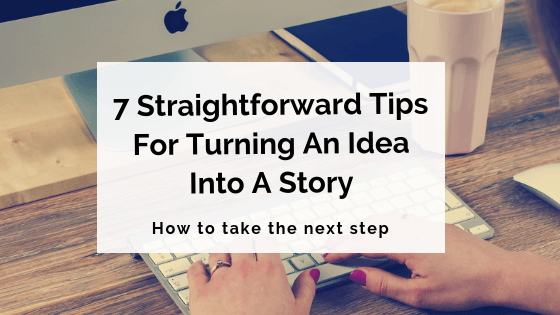There are few things more magical to a writer than an idea. That initial spark of inspiration, that tiny kernel that nestles itself in your mind – slowly growing and developing, taking shape and form…
There’s no doubt that ideation is one of the most exciting parts of the writing process.

But for many writers, taking an idea past its initial stages is where they find themselves stuck. Having an idea is one thing; transforming it into a fully fleshed-out story is another.
So is there anything a writer can do to make the task of turning an idea into a story easier? Luckily, the answer is yes – there are multiple things you can do to kickstart the process!
Let’s take a look at a few top tips.
1. Brainstorm, brainstorm, brainstorm
Brainstorming is something all writers should be doing. Whether you’re writing a short story or planning a novel, brainstorming is essential for exploring ideas, allowing them to morph into the bare bones of a proper story.
Whenever you find yourself with a shiny new idea, the first thing you should do is write it down (or type it out). It doesn’t need to read well, or even make sense! Just get all your thoughts about the idea down on paper – a brain-dump, if you will.
The more aspects of the idea you have written down to work with, the better. You won’t use everything you write down here, but you never know where each random thought and tangent might lead, so don’t hold back.

Once you’ve got everything written down, it’s time for some more focused brainstorming. This is where you start to think actively about the facets of your idea and the directions your potential story might take.
Common techniques for this kind of brainstorming include:
- Mind-mapping. This can help you create a visual representation of how different aspects of your idea link up, including themes and potential plot points. Some writers like to mind-map by hand on a large sheet of paper; others prefer to use mind-mapping software.
- Asking ‘what if?’ questions. ‘What if?’ are two of the most inspiring words for any writer. Asking ‘what if?’ questions can help you devise scenarios, situations and concepts that might form the basis of your plot and story.
- Freewriting. This involves putting hand to keyboard or pen to paper and allowing the words to flow without thinking too much about them. It’s similar to the initial brain-dump you performed, but can be done with clearer direction and purpose in mind. Decide on a particular aspect of your idea you want to explore further, and write freely about that, and only that, for a set amount of time. You might be surprised by what comes out.
2. Research for further inspiration
Once you’ve done some extensive brainstorming, it’s a good idea to move onto some old-fashioned research. Time to hit the internet/library/real world and go exploring!
Researching can help clarify existing ideas, spark further ideas, and keep your thoughts flowing, as well as providing you with some solid facts to inform the potential direction of your story.

Depending on what kind of story you’re planning to write, you might want to research:
- Historical time periods/events
- Real-life locations, people, occupations, cultures etc.
- Scientific, social or philosophical concepts
Researching can also involve reading other books in the same wheelhouse as your idea/potential story. Look into other books in your genre/subgenre, or any that sound similar to the kind of story you’re thinking of telling.
If you’re planning to make a career out of your writing, it’s always handy to know what’s happening in the current publishing scene, as well as having an idea of what’s been popular and successful in the past.
For more in-depth research tips, check out our full guide to researching a novel.
3. Refine and clarify your central idea
Throughout the brainstorming and research process, you’ll likely find your idea becoming naturally clearer and more refined in your mind.
However, after exploring all these new avenues and ingesting so much new information, it’s a good idea to stop and actively revisit your central idea before you move onto the next step.

Using what you’ve learned throughout your brainstorming and research sessions, try to turn your idea from a vague concept into a clear premise. This means getting specific about the exact story you’re going to tell.
It can help here to identify what’s unique about your idea and focus on that aspect to create a detailed premise. Don’t feel you’re locked into anything, though; things can (and likely will) change later on.
Reviewing and distilling your idea now is just a way to consolidate all the work you’ve done so far and push you along to the next step, which is…
4. Focus on character goals and conflict
When turning an idea into a story, it always pays to focus on two failsafe areas: characters and conflict.
These two aspects are at the heart of each and every successful story, so the earlier you tap into them, the better.
Goals and motivations are the most important aspects of character development, and conflict is the most important aspect of story. Drilling down into what drives your characters to do what they do, and what conflicts (both external and internal) might arise because of this, is a great way to bridge the gap between idea and story.

Brainstorm some scenes and scenarios that will allow you to show character development, raise stakes and increase tension. This can give you a few good kicking-off points for starting the actual writing process.
Remember, though, that there’s plenty of time to develop your characters as you write and revise. They don’t need to be fully fleshed-out before you even put them on the page. To take them from idea to story level, you just need a basic understanding of what they want, and what’s going to stop them from getting it.
5. Weave smaller ideas into your central concept
Sometimes, an idea can seem like it’s not big enough to be turned into an entire novel-length story. If your concept or premise is fairly simple, you might be worried that you don’t have enough material there to start expanding it into a full story.
If this is the case, it’s time to go back to your results from Step 1 and identify some potential subplots, themes and smaller ideas that can be woven throughout your main idea.
Take a look at all the ideas that branched off from your initial idea when you completed your brainstorming. Ask yourself:
- What different levels of the main idea are there to explore?
- What related concepts or themes can be woven together to create a richer story tapestry?
- Are there any subplots that can support the main plot, advance your character development and generally flesh out your story more fully?

This step comes with an important caveat: never include other ideas and subplots simply for the sake of it. They have to be there for a reason; they must serve the overall story you’re aiming to tell.
If you’re having trouble identifying additional ideas or themes to explore, it might be time to revisit and rework your original idea, and consider other ways you can approach it in order to turn it into a fully realised story.
Now, it’s time for our last two tips…
6. Give yourself time
Sometimes, turning an idea into a story simply takes time.
Some ideas arrive practically fully-formed, but others need to sit in the back of your mind for a while, marinating and developing subconsciously.
If you don’t feel like you’re ready to start writing a particular story just yet, go with your instinct and wait a little longer.
Keep thinking about the idea and allowing it to turn over in your mind. Time might be all it takes for the pieces to come together into a coherent whole.
7. … But don’t forget to start writing!
Yes, some ideas need more time than others to germinate and develop into stories. But don’t be tempted to use this as an excuse to put off writing and stay stuck in the ‘idea’ stage forever.

Sometimes, the sole reason a writer gets caught in limbo between idea and story is fear. You might be afraid that your idea isn’t good enough; that you’ll never be able to write it properly and do it justice; that you’re wasting your time even trying.
These feelings are all perfectly normal, and part and parcel of being a writer. (See our piece on impostor syndrome for more insight!)
What it often takes to finally bridge the gap between idea and story is a leap of faith. You might never feel completely ready to write a story, but that’s OK. Don’t put it off forever – just start writing, and see what happens.
You might be surprised at the way your idea begins to transform from idea to proper story the minute you actually start to write.
***
Writers, how do you go about the process of turning an idea into a story? Share your experiences with us in the comments!
3 responses to “7 Straightforward Tips For Turning An Idea Into A Story”
Thank you for writing this post. Although I know how a person does the preliminary work of a project is up to the individual, because I dearly lack self-confidence, this post let me know I am on the right trail.
Great to hear, Glynis! Wishing you the best of luck with your your project. 🙂
Thank you so much for your insightful post. I am one of those people who get so caught up in research that I don’t even reach close to writing. This post helped a lot. <3